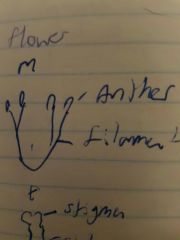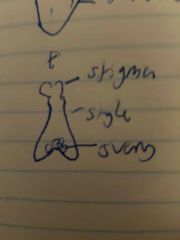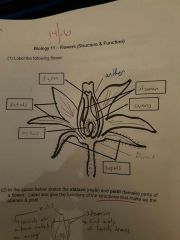![]()
![]()
![]()
Use LEFT and RIGHT arrow keys to navigate between flashcards;
Use UP and DOWN arrow keys to flip the card;
H to show hint;
A reads text to speech;
25 Cards in this Set
- Front
- Back
|
Angiosperms |
Do not have naked seeds= enclosed in fruit, pollinated by insects, body=Sporophyte, 2 basic stems: herbacious=flesh->annuals and woody= perennial |
|
|
Monocot |
1 Catyledon, parallel veins, random arrangement of veins, fibrous roots, petals in multiples of 3 |
|
|
Dicot |
2 Catyledon, branching veins, circular vein arrangement, taproot, petals in multiples of 4 or 5 |
|
|
Petals |
Attract pollinators |
|
|
Sepals |
Protect developing flower |
|
|
Receptacle |
Structural |
|
|
Stamin (male) |

Anther and filament |
|
|
Anther |
Produces pollen |
|
|
Filament |
Holds up anther |
|
|
Pistil (female) |

Stigma, style, ovary |
|
|
Stigma |
Stick to collect pollen from pollinators |
|
|
Style |
Holds up Stigma |
|
|
Ovary |
Contains ovule, turns into fruit |
|
|
Ovule |
Turns into seed (Fertilized plant embryo) |
|
|
Seed |
Young embryo packed in food source |
|
|
Double fertilization |
Pollen grain releases 2 gametes, one fuses with egg become embryo/zygote and the other combines with polar nuclear to become the endosperm |
|
|
Epicotyl |
Turns into leaves |
|
|
Radicale |
Turns into roots |
|
|
Hypocotyl |
Turns into stem |
|
|
Catyledon |
Turns into endosperm |
|
|
Methods of seed dispersal |
Angiosperms want to scatter seeds far from food source so new plants don't compete eg fruits/wind/burrs |
|
|
Flower parts |

|
|
|
Cross pollination |
Transfer of pollen from one flower to another, ensure this happens by have male and female parts develope at different times |
|
|
How sperms gets to ovary |

Flower grows pollen tube to ovary |
|
|
Endosperm |
3 nuclei that form the triploid eg rice or nuts |

